
Bratislava is the capital city and the cultural and economic centre of Slovakia. It is home to several museums and galleries, including the Slovak National Museum and the Slovak National Gallery.

Bratislava is the capital city and the cultural and economic centre of Slovakia. It is home to several museums and galleries, including the Slovak National Museum and the Slovak National Gallery.
The Slovak National Museum (Slovenské národné múzeum) has its headquarters in Bratislava on Vajanského nábrežie (a riverfront street in the Old Town), along with the Natural Science Museum, which is one of its subdivisions.
The Slovak Museum was established in Bratislava in 1940 by merging the Slovak National Geographic and History Museum and the Agricultural Museum. In 1961 the Slovak National Museum in Martin was merged with the Slovak Museum, creating the new Slovak National Museum based in Bratislava. The SNM is the highest institution focusing on scientific research and cultural education in the field of museological activity in Slovakia. The SNM manages 16 specialized museums in and outside Bratislava. [1]
The museums situated in Bratislava are:
The Bratislava City Museum (Múzeum mesta Bratislavy) established in 1868 is the oldest museum in continuous operation in Slovakia. [2] The museum's primary goal is to chronicle Bratislava's history in various forms from the earliest periods using historical and archaeological collections. [3] The museum offers nine permanent displays in eight specialized museums, mainly situated in the Old Town. The Museum of the City History situated in the Old Town Hall documents Bratislava's history from the mediaeval period to the 20th century. The Museum of Arms is located on Michael's (Michalská) Street at Michael's Gate. The museum focuses on Bratislava's history and developments in firearms, gunsmithing, metalworking, and town fortifications. The building also offers a view over the historical centre and its surroundings. The Museum of Clocks is situated on Jewish (Židovská) Street below Bratislava Castle, in the Rococo-style "House of the Good Shepherd", built from 1760 to 1765. The museum exhibits antique clocks from the end of 17th to the end of the 19th century, mainly from Bratislava's clockmakers. Other displays include the Devín Castle and ancient Gerulata.
The Bratislava Transport Museum, a branch of the Slovak Technical Museum in Košice, is situated on the site of the first steam-railway station in Bratislava on Šancová Street, near the current main railway station. It was opened on June 24, 1999.
The Water Museum (Vodárenské múzeum), which is administered by the Bratislava Water Company (Bratislavská vodárenská spoločnosť), is located in Karlova Ves. It focuses on history of waterworks and water supply in Bratislava, exhibiting tools, machines and photographs.
The Museum of Education and Pedagogy was established in 1970 by the Department of Education and is administered by the Institute of Information and Prognoses of Education (Ústav informácií a prognóz školstva). The museum contains almost 40,000 exhibits from the 16th to the 20th century.

The Slovak National Gallery (abbr. SNG), founded in 1948, is the biggest network of galleries in Slovakia. Two displays in Bratislava are situated in Esterházy Palace (Esterházyho palác) and the Water Barracks (Vodné kasárne), adjacent one to another. They are located on the Danube riverfront in the Old Town. [4]
The Bratislava City Gallery, founded in 1961, is the second biggest Slovak gallery of its kind. It stores about 35,000 pieces of Slovak and international art and offers permanent displays in Pálffy Palace and Mirbach Palace, located in the Old Town. Danubiana Art Museum, one of the youngest art museums in Europe, is situated near Čunovo waterworks (part of Gabčíkovo Waterworks). It opened on September 9, 2000. Gallery Enter, near the Bratislava City Gallery, is host to new digital media art.

Slovakia, officially the Slovak Republic, is a landlocked country in Central Europe. It is bordered by Poland to the north, Ukraine to the east, Hungary to the south, Austria to the west, and the Czech Republic to the northwest. Slovakia's mostly mountainous territory spans about 49,000 square kilometres (19,000 sq mi), with a population of over 5.4 million. The capital and largest city is Bratislava, while the second largest city is Košice.

Žilina is a city in north-western Slovakia, around 200 kilometres (120 mi) from the capital Bratislava, close to both the Czech and Polish borders. It is the fourth largest city of Slovakia with a population of approximately 80,000, an important industrial center, the largest city on the Váh river, and the seat of a kraj and of an okres. It belongs to the Upper Váh region of tourism.

The Old Town of Bratislava is the historic center and one of the boroughs of Bratislava, in the Bratislava Region of Slovakia. It is coextensive with the smallest Slovak administrative district by area, Bratislava I. It contains the small, but preserved medieval city center, Bratislava Castle and other important landmarks. Bratislava's Old Town is known for its many churches, the Bratislava Riverfront and cultural institutions, it is also the location of most of the foreign states embassies and important Slovak institutions including the National Council of the Slovak Republic; the Summer Archbishop's Palace, seat of the Government of Slovakia; and Grassalkovich Palace, seat of the President of Slovakia.

The East Slovak Museum in Košice, Slovakia, is one of the oldest Slovak museums, founded in 1872. It is located in the Old Town borough of Košice, at Námestie maratóncov.
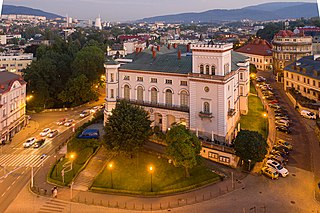
The Bielsko-Biała Museum, also known as the Castle of the Sułkowski Princes is a museum for the city of Bielsko-Biała, Poland located in the historical Bielsko Castle. Three local branches of the museum have been established since the 1970s: the Julian Fałat Museum, the Museum of Technology and Textile Industry, and the Weaver's House Museum.

The National Museum in Kraków, popularly abbreviated as MNK, is the largest museum in Poland, and the main branch of Poland's National Museum, which has several independent branches with permanent collections around the country. Established in 1879, the museum consists of 21 departments which are divided by art period: 11 galleries, 2 libraries, and 12 conservation workshops. It holds some 780,000 art objects, spanning from classical archeology to modern art, with special focus on Polish painting.
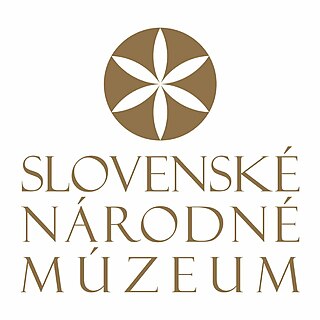
The Slovak National Museum is the most important institution focusing on scientific research and cultural education in the field of museology in Slovakia. Its beginnings "are connected with the endeavour of the Slovak nation for national emancipation and self-determination".
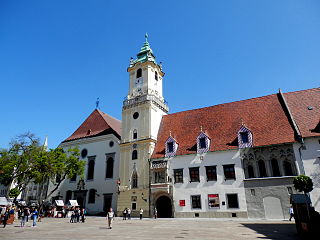
The Bratislava City Museum is a museum in Bratislava, Slovakia, established in 1868. Its headquarters are located in the Old Town, near the Main Square at the Old Town Hall. The museum is owned by one of the 11 allowance organizations of the City of Bratislava.

The Slovak National Gallery is a network of galleries in Slovakia. It has its headquarters in Bratislava.

Esterházy Palace is a Neo-Renaissance style building in the Old Town of Bratislava, Slovakia, near the Danube riverfront, built in the 1870s. The building was reconstructed in the 1920s and in the 1950s, when it was adapted for the Slovak National Gallery.

The culture of Slovakia is influenced by its Catholic culture, it’s various folk traditions, and its location in Central Europe. Slovakian culture shares certain similarities with the cultural traditions of its neighbouring countries: Poland, Ukraine, Hungary, Austria and Czech Republic.

Baron László Mednyánszky or Ladislaus Josephus Balthasar Eustachius Mednyánszky, a Slovak-Hungarian painter-philosopher, is one of the most enigmatic figures in the history of Hungarian art. Despite an aristocratic background, he spent most of his life moving around Europe working as an artist. Mednyánszky spent considerable periods in seclusion but mingled with people across society – in the aristocracy, art world, peasantry and army – many of whom became the subjects of his paintings. His most important works depict scenes of nature and poor, working people, particularly from his home region in Kingdom of Hungary. He is also known as a painter of folklore of Upper Hungary.

Bratislava, historically known as Preßburg (Pressburg), is the capital and largest city of Slovakia. Officially, the population of the city is about 475,000; however, it is estimated to be more than 660,000—approximately 140% of the official figures. Bratislava is in southwestern Slovakia at the foot of the Little Carpathians, occupying both banks of the River Danube and the left bank of the River Morava. Bordering Austria and Hungary, it is the only national capital to border two sovereign states.

Chatam Sofer Memorial, formerly the Old Jewish Cemetery is the burial place and memorial of Moses Sofer, a prominent orthodox rabbi from the 19th century, built on the site of a 17th-century Jewish cemetery in Bratislava, Slovakia. The historical cemetery was mostly destroyed with the construction of the road tunnel under Bratislava Castle in 1943 but negotiations with the clero-fascist Slovak leader Jozef Tiso allowed an important fraction of the cemetery containing the graves of the rabbis to be preserved encased in concrete. Later, when the tunnel was converted for public transport trams a tram stop was constructed above the site. In 2002 a modern memorial was erected above the site and it was partially opened to the public.

RONA a.s. is a Slovak drinking glass manufacturer, established in Lednické Rovne, Slovakia, in 1892. The name RONA comes from the former naming of the village ‘‘Lednicz Rone’’. The company manufactures unleaded drinking glasses, known as crystal glass. 96% of production is exported and is available in more than 80 countries worldwide. The yearly production of the company exceeds 60 million pieces (2016). Product segments include households, the gastronomy business, aerospace, and ship catering.

Podhradie is a historical part of Bratislava, the capital of Slovakia, situated around the Bratislava Castle hill. Today, it consists of the areas of Zuckermandel, Vydrica and the area above Židovská Street. Until the 13th century, Podhradie consisted of various settlements situated around the castle, outside of the Bratislava city walls with all land on the castle hill belonging to the castle. Zuckermandel and Vydrica were incorporated in 1848 as the 4. district of the city of Bratislava and from 1850 until its partial demolition in the half of 20th century it was called Mesto Márie Terézie.
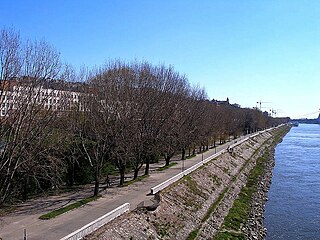
Bratislava Riverfront is a riverfront on the river Danube located on the Old Town side of Bratislava, Slovakia. It extends from the Karloveská bay near the Lafranconi Bridge to the Port of Bratislava and Harbour Bridge. In the past, the riverfront included the Coronation Hill, where the newly crowned Kings of Hungary would recite an oath and make crosses with their sword in four cardinal directions to show their resolution to defend the country. The hill was demolished in 1870 when the shores of the Danube were strengthened.

Košice Staré Mesto is a borough of Košice, Slovakia. It encompasses the historical centre of the city, consisting of the medieval and early modern core of Košice, with many preserved historical buildings of several architectural styles, and a small number of more modern architecture. The borough also includes the immediate environs of the historical centre.
The architecture of Slovakia has a long, rich and diverse history. Besides Roman ruins, Slovakia hosts several Romanesque and Gothic castles and churches, most notably Spiš Castle, which were built at the time of the Kingdom of Hungary. Renaissance architecture was of particular relevance in town hall squares, such as in Bardejov and Levoča. Affluent architecture in the following centuries made use of Baroque, Rococo and historicist styles, while vernacular architecture in the countryside developed a specific style of wooden houses and wooden churches. In the 20th century, Slovakia knew Art Nouveau and modernist architecture, including socialist modernism, and finally contemporary architecture.
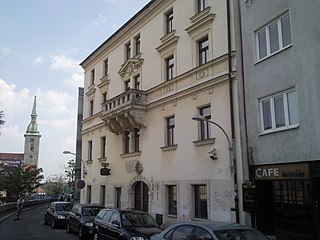
The Museum of Jewish Culture is a museum in Bratislava, Slovakia, which focuses on the history of the Jews in Slovakia. Opened in 1993, it is a component of the Slovak National Museum, and its director is Pavol Mešťan.